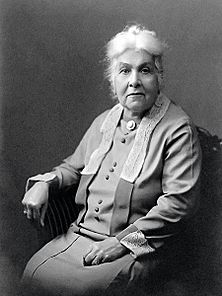Diana Abgar facts for kids
Quick facts for kids
Diana Abgar
|
|
|---|---|
 |
|
| Armenia Honorary consul to Japan | |
| In office 1920–1920 |
|
| Preceded by | position established |
| Succeeded by | position abolished |
| Personal details | |
| Born | 17 October 1859 Rangoon, British Burma |
| Died | 8 July 1937 (aged 77) Yokohama, Japan |
| Occupation | Writer, merchant and humanitarian |
Diana Abgar (also spelled Apcar) was an amazing Armenian writer and humanitarian. A humanitarian is someone who works to improve the lives of others. She was born on October 17, 1859, and passed away on July 8, 1937.
She made history as the first Armenian woman diplomat. A diplomat is a person who represents their country in another country. Diana was appointed as the Honorary Consul for the short-lived First Republic of Armenia in Japan. This made her one of the very first women in the world to hold such a diplomatic role in the 20th century.
Contents
A Look at Diana Abgar's Life
Diana Agabeg was born in Rangoon, which is now Yangon, Myanmar. This was on October 17, 1859. Her family was Armenian, but they had moved from New Julfa, Iran, to Southeast Asia. Diana was the youngest of seven children.
She grew up in Calcutta (now Kolkata) and went to a local convent school. Diana was very smart. She learned to speak English, Armenian, and Hindustani fluently.
Later, she married Apcar Michael Apcar. His family was also Armenian and came from the same area in Iran as Diana's family. The Apcar family became very successful business people. They were especially good at importing and exporting a shiny material called shellac.
In 1891, Diana and her husband moved to Japan. They wanted to make their family business even bigger there. They had five children, but sadly, only three of them lived to be adults.
As Diana got older, she faced some health challenges. She had trouble seeing and hearing, and she also had arthritis. She passed away in Yokohama, Japan, on July 8, 1937. She was 77 years old. She is buried next to her husband in a cemetery for foreigners. Today, a group called the Society of Armenian-Japanese Friendship takes care of her grave.
Diana Abgar's Diplomatic Work
When the First Republic of Armenia became independent on May 28, 1918, no other country officially recognized it. But in 1920, thanks to Diana Abgar's hard work, Japan became the first country to recognize Armenia's independence!
Because of her efforts, Hamo Ohanjanyan, who was Armenia's Foreign Minister, made Diana Abgar the Honorary Consul to Japan. This was a huge achievement. It made her the first Armenian woman diplomat. She was also one of the first women ever to be appointed to a diplomatic job in the 1900s. However, Armenia's first republic fell later that same year, in 1920. Because of this, her diplomatic role ended.
Diana Abgar's Writings
After her son took over the family business in Japan, Diana had more time. She focused on helping people, writing, and her diplomatic work. She wrote for many newspapers and journals. These included The Japan Advertiser, The Far East, The Japan Gazette, and Armenia (which later became New Armenia).
She wrote a lot about people who were suffering. She especially wrote about the Armenian people's struggles in the Ottoman Empire. She wanted to make people around the world aware of what was happening. By 1920, she had written over nine books about the Armenian Genocide. She also wrote many articles about how countries interact and how powerful empires affected world peace.
Here are some of her important books:
- The Great Evil. Yokohama, Japan: “Japan Gazette” Press, 1914, 114 pp.
- Peace and No Peace. Yokohama, Japan: “Japan Gazette” Press, 1912, 101 pp.
- The Peace Problem. Yokohama, Japan: “Japan Gazette” Press, 1912, 131 pp.
- On the Cross of Europe’s Imperialism: Armenia Crucified. Yokohama, Japan: 1918, 116 pp.
- In His Name ... Yokohama, Japan: “Japan Gazette,” 1911. 52 pp.
- Betrayed Armenia. Yokohama, Japan: “Japan Gazette” Press, 1910, 77 pp.
- The Truth about the Armenian Massacres. Yokohama, Japan: “Japan Gazette,” 1910, 26 pp.
- Home Stories of the War. Kobe, Japan: The Kaneko Printing Works, 1905, 47 pp.
- Susan. Yokohama, Japan: Kelly and Walsh, Limited, 1892, 109 pp.
The Stateless Diplomat Film
Diana Abgar's great-granddaughter, Mimi Malayan, found a box of Diana's old writings in 2004. She started researching Diana's life. In 2018, Mimi finished a documentary film called The Stateless Diplomat. A documentary is a movie that tells a true story. This film used writings that had never been seen before. Mimi also created a website where many of Diana's writings are now available for everyone to read.


